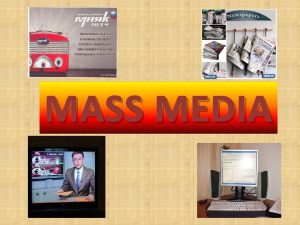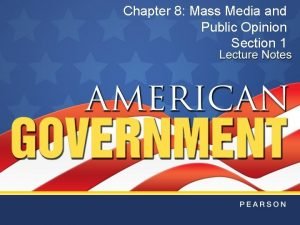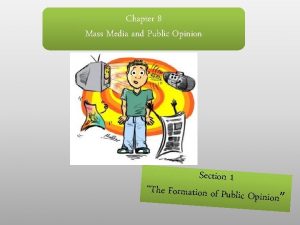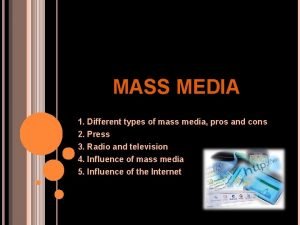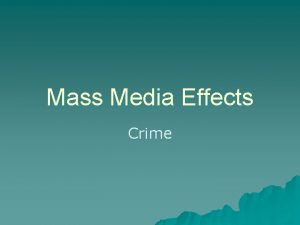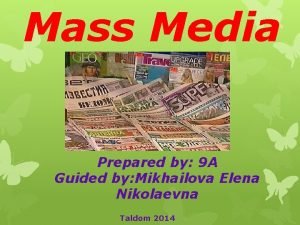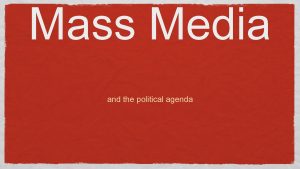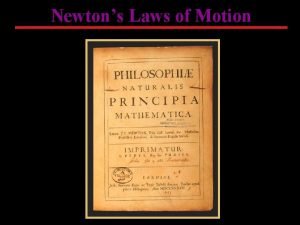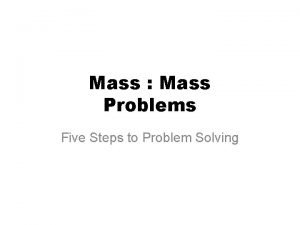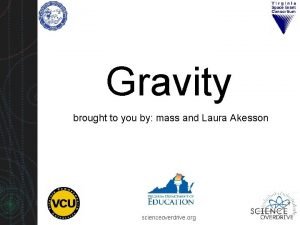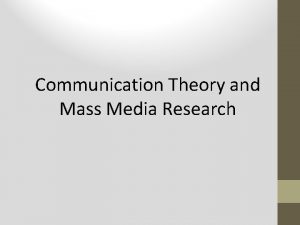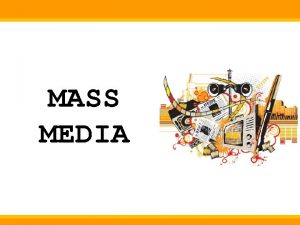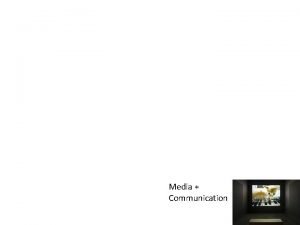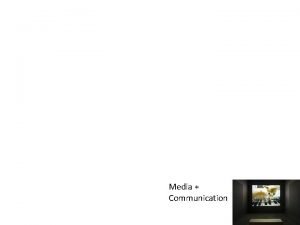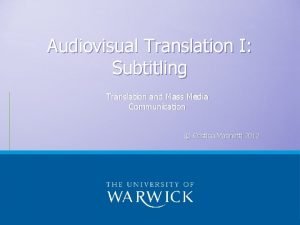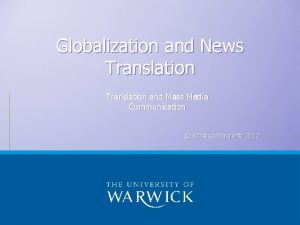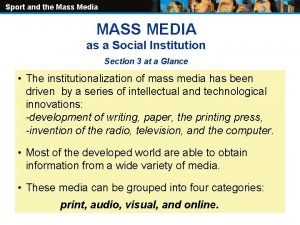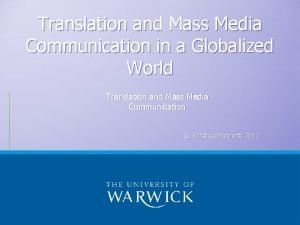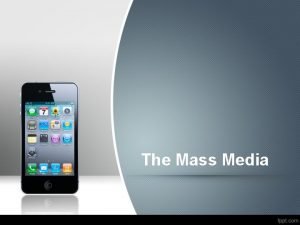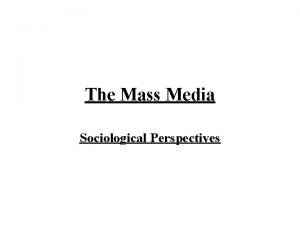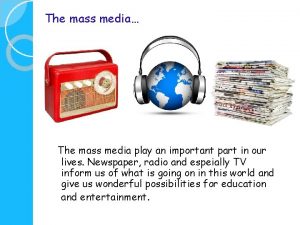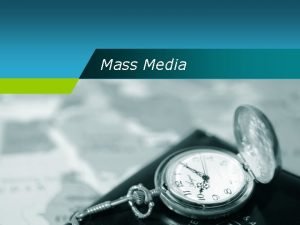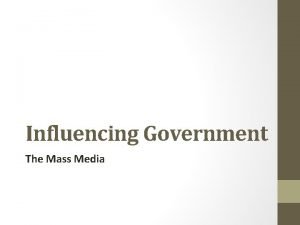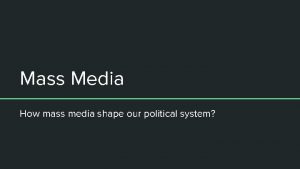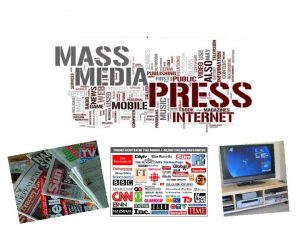Translation Technology Translation and Mass Media Communication Cristina

























- Slides: 25

Translation Technology Translation and Mass Media Communication © Cristina Marinetti 2012

Changes in the context of translation Informational Global ‘The contemporary change of paradigm can be seen as a shift from a technology based primarily on cheap input of energy to one predominantly based on cheap input of information’ (Freeman qtd in Cronin 10) ‘The new economy is global because the central activities of production, consumption and circulation, as well as their components (capital, labour, raw material, management, information, markets), are organized on a global scale, either directly or through a network of connections between different economic agents’ (Cronin 11)

Teletranslation: an infrastructural shift Industrial society Physical transportation And face to face Communication with print media Translation Information society Today’s transitional Computer-mediated society communication Teletranslation

Conventional Translation - text for paper-based circulation - asynchronous no engineering input after-thought

Teletranslation • Processing of text in electronic form • Both asynchronous and synchronous texts • Computer and network assisted translation with a range of tools • Engineering inputs • Adaptation of non-textual elements • Translation is foregrounded in the design of texts – internationalization (O’Hagan 23)

Translation technology continuum automation Automatic translation Translation process automated by use of Machine Translation (MT) human involvement Computer-aided Translation (CAT) Translation process aided by electronic tools such as Translation Memory systems (TM) Unaided translation Translation process not aided by any electronic tools

Machine Translation: a threat, a solution or a tool? • A threat? • Under the present circumstances – No • A solution? • Partially > gist translation • A tool? • Increasingly > pre ad post editing of results + use of internationalization techniques


Compare the source text with the backtranslated version from Spanish and consider to what extent you think that this translation is usable. Is the translated text worth editing or do you think it would be better to start from scratch? Underline the elements which you think have been particularly problematic for the machine to translate. What do these difficult elements have in common?

Now try to simplify the language of the source text in view of translation. Internationalize it so as to make it as simple and understandable as possible. What changes did you have to make? Has this process involved gain or loss of meaning? What do you think could be the long-term effects of the use of internationalization of texts for translation?

Internationalized version (back translated from Spanish) It is time for the British television to launch Kerry Katona as a presenter. She will participate in the show called Mr. and lady. The previous member of the atomic kitten the music band, that is 27, and the husband, Mark Croft, who is 36 will examine their union in this new show the next month. We revealed that ITV will bring this old show back. This time will offer pairs of celebrities instead of regular guests. Kerry and mark will be the first guests in the show. They are participating to convince the public that their union is true. LIKE in the past, each pair will have to answer intimate questions on one another.

Translation technology continuum automation Automatic translation Translation process automated by use of Machine Translation (MT) human involvement Computer-aided Translation (CAT) Translation process aided by electronic tools such as Translation Memory systems (TM) Unaided translation Translation process not aided by any electronic tools

CAT tools • Professional translators use technology for a number of different tasks. CAT technology have been develop to help the translator perform the following: 1. Information retrieval 2. Terminology management and translation processing (Translation memory) 3. Localization

Terminology management and translation processing (Translation memory) • A translation memory is a kind of linguistic • • database used to store source texts and their translations. Each text is broken down into short segments. Each source text segment and its translated equivalent then make up a translation unit. In other words, it is a searchable collection of translation units. In its simplest form, a translation memory can be viewed as a list of source text segment that are explicitly aligned with their target counterparts

How do translation memory systems work? • A translation memory system splits the pair of texts • • • (original plus translation) into segments. then aligns them as the text is translated sentence by sentence. It is this pair of aligned segments which is often known as a translation unit or TU. Each TU is then stored and indexed in a database or translation memory When the user starts a new translation, whose source text is similar to one already in the database, the system will recognize the similar segments, retrieve them, and suggest them to the user. Any translation memory system is effectively an empty database when first used. The bigger the TM database gets, the more valuable it is.

The main principle of TM systems • TM systems must carry out the following processes as • • • part of each project. Firstly, the source text must be filtered to separate translatable segments from formatting information. Additionally the source text must be split into smaller chunks known as segments. Once filtered and segmented, the translatable segments are ready to be edited by the translator using the TM system Throughout this process the translator will also update the translation memory and terminology database. Once the translation has been completed it can be exported in its final form which will replicate the structure, layout and formatting of the original source text.

The concept of fuzzy matching • An intrinsic feature of TM systems is the ability to distinguish between identical, exact 100% matches and those that are only similar, i. e. fuzzy matches. A fuzzy match is a match which is anything less then exact. For example: – Source segment: ‘ Many thanks for visiting the website of the European Union’ – TU already present in the database: • EN: ‘Thank you for visiting the official website of the European • Parliament’ IT: ‘Vi ringraziamo per aver visitato il sito ufficiale del Parlamento Europeo’ • When presented with the source text above, the TM system would like to suggest the partial match already present in its database. Fuzzy (or partial) matches are sentences that match a sentence in the TM up to a certain percentage proportion, typically around 70 -75%.

The suitability of text types • Translation Memory systems are best suited and most • • useful when translating certain types of text. The primary requirement for a text to be translated using a TM system is that the source text must be available in electronic format. Translation memory works best with material that contains a large proportion of repeated or partially repeated text, such as: – instruction and operation manuals – Software manuals and specifications – Help files • Translation memory systems can also be useful to translate documents which do not necessarily contain repetitions but which are updated periodically based around the same content, such as monthly reports presenting the same data each month and contracts that are modified periodically.

Advantages and disadvantages of using Translation Memory systems. • Advantages: – TM systems are highly suitable for translating technical documentation and document containing specialized vocabulary. – TM systems accelerate the overall translation process: since translation memories ‘remember’ previously translated material, translator have to translate it only once. – Larger documents can be translated and delivered more quickly; – Translated documents are more consistent, including in their handling of common definitions, phrasing and terminology. This is particularly important when different translators are working on the same project – The use of technology leads to uniformity of style and general improvement of translation quality – Because of the efficacy of fuzzy and exact matching, users can experience a significant productivity gain.

Advantages and disadvantages of using Translation Memory systems. • Disadvantages: – A large amount of work is required in order to be integrated into already running translation processes – Source documents must be available in electronic format – The do not support all text formats (no PDFs for instance) – It takes a large amount of time to learn how to use a TM system – The full versions are quite expensive and the initial outlay can be considerable – Text quality is not always guaranteed as errors can be propagated if the TM is not filled in and edited correctly – Risk of automation, de-skilling of the translator – Makes exploitation of human translators easier – Not suitable for translating non repetitive texts – It is difficult to retrieve contextual information – Significant time investment is required to produce a useful Translation Memory.

For next week • Download & Instal Wordfast Classics 6 at http: //www. wordfast. net/index. php? which page=downloadpage&lang=engb • Download the three sample texts (1, 2, 3) from the course website. • Bring your (fully charged) laptop to class.

Reading: • O’Hagan Translation-mediated communication in the digital world. (Ch. 1, 2) • Pym, A. Localization, Translation and Distribution. • • (Ch. 1) Ritter, Introduction to Translation Memory and Machine Translation (online) www. mcelorytranslation. com/pdfs/published_ritt er 2. pdf Shuttleworth & Lagoudaki Translation Memory Systems (online) http: //translation. hau. gr/telamon/files/Mark. Shutt leworth_Elina. Lagoudaki_Paper. AICTI. pdf



 Relative atomic mass of beryllium
Relative atomic mass of beryllium Distinguish between mass number and atomic mass.
Distinguish between mass number and atomic mass. O
O Atomic mass vs mass number
Atomic mass vs mass number What is communicative translation?
What is communicative translation? Left and right transformations
Left and right transformations Similarities of people as media and people in media
Similarities of people as media and people in media Mass media questions and answers
Mass media questions and answers Mass media and pop culture
Mass media and pop culture Chapter 8 mass media and public opinion worksheet answers
Chapter 8 mass media and public opinion worksheet answers Chapter 8 mass media and public opinion worksheet answers
Chapter 8 mass media and public opinion worksheet answers Specialty media advantages and disadvantages
Specialty media advantages and disadvantages Kind of mass media
Kind of mass media Mass media and crime
Mass media and crime Sport and the mass media guided reading
Sport and the mass media guided reading The mass media and the political agenda
The mass media and the political agenda Ideal stoichiometric calculations
Ideal stoichiometric calculations Mass percent composition
Mass percent composition Inertial mass vs gravitational mass
Inertial mass vs gravitational mass Gram to mole
Gram to mole Convert grams to mol
Convert grams to mol Molar mass units
Molar mass units Mole to particles
Mole to particles Molar mass units
Molar mass units Mass/mass problems
Mass/mass problems Gravitational mass vs inertial mass
Gravitational mass vs inertial mass







